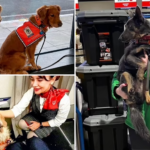Dogs like us behave differently. They show signs of jealousy, for example when they inflate the smell of another dog on your clothes because they want to be a dog no. 1 in your life.
They also have their dominant paws, just like humans. You will recognize its dominant side by which paw it gives when it shakes hands or grabs things.
Read More: Playtime Leaves Fluffy Puppy Completely Covered in Mud, Except For His Face
When the dog is relaxed, it flies slowly with its tail from one side to the other, but when it is happy or when it sees a friendly person, it will start moving it faster, moving its hips as well. If the tail is straight up, it means self-confidence or aggression.
But they also have a very strong sense of smell and can recognize when someone is sick.
For centuries, humans have used their sense of smell as a tool for medical diagnostics, while dogs have detected cancer in more than 2,000 modern scientific studies.
Many countries that have achieved the greatest success in maintaining a small number of patients with COVID-19 have done so with the widespread use of testing. According to scientists, using dogs could speed up the testing process.
For the Coronavirus study, the authors collected 168 specimens of sweating armpits from people with positive results who did not require significant medical supervision. They used 18 dogs that had been trained to detect explosives, colorectal cancer, and survivors during search and rescue missions.
Jars were containing specimens of the more severe positive sweating from COVID-19, were placed in a line. The funnels were inserted into the jars, allowing the dogs to place their noses close to the specimen. The trials were conducted with 3, 4, 6, and 7 jars, with only one containing a positive sample.
The results showed that positive people with COVID-19 produced axillary sweat that had a different smell for dogs than those who were negative people with COVID-19, the study authors wrote.
Read More: This Artist Disneyfies People’s Pet Photos And It’s Amazing
Researchers advise that all countries should take this approach to have fast, accurate and inexpensive tests.






